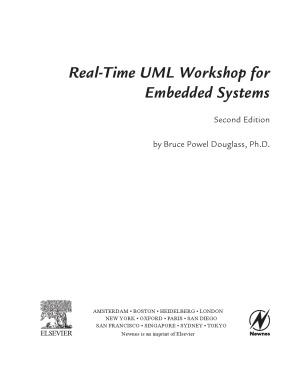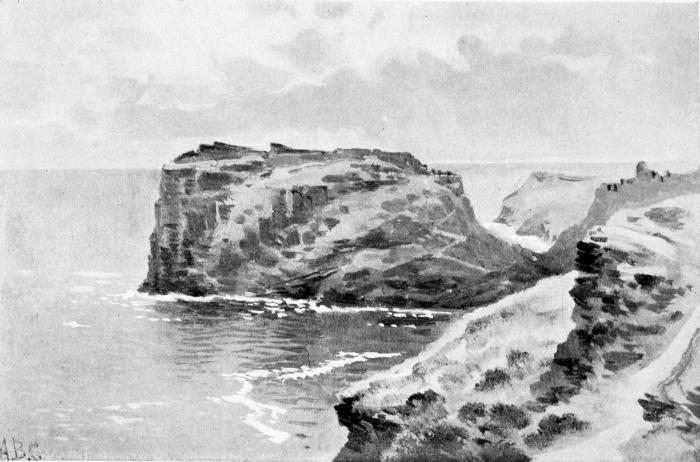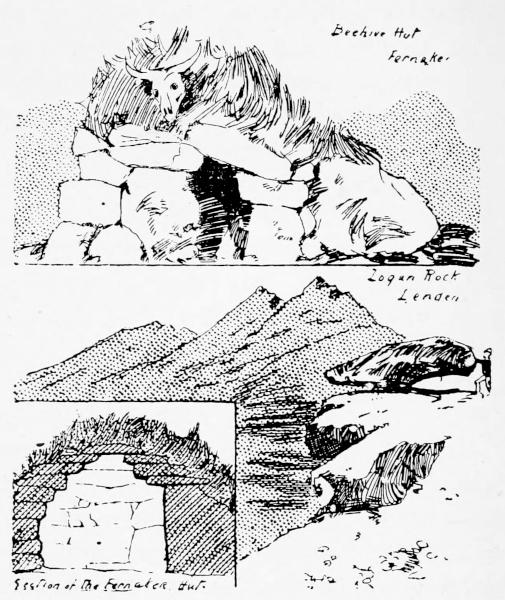RealTimeUMLWorkshopforEmbeddedSystems
2ndEditionBrucePowelDouglass
https://ebookgate.com/product/real-time-umlworkshop-for-embedded-systems-2nd-edition-brucepowel-douglass/

Download more ebook from https://ebookgate.com
More products digital (pdf, epub, mobi) instant download maybe you interests ...

Design Patterns for Embedded Systems in C An Embedded Software Engineering Toolkit 1st Edition Bruce Powel Douglass
https://ebookgate.com/product/design-patterns-for-embeddedsystems-in-c-an-embedded-software-engineering-toolkit-1stedition-bruce-powel-douglass/

Real Time Embedded Components and Systems 1st Edition
Sam Siewert
https://ebookgate.com/product/real-time-embedded-components-andsystems-1st-edition-sam-siewert/

Linux for embedded and real time applications 2nd Edition Doug Abbott
https://ebookgate.com/product/linux-for-embedded-and-real-timeapplications-2nd-edition-doug-abbott/

Embedded Microcomputer Systems Real Time Interfacing 3rd Edition Jonathan W. Valvano
https://ebookgate.com/product/embedded-microcomputer-systemsreal-time-interfacing-3rd-edition-jonathan-w-valvano/

Real Time Systems Design and Analysis 3rd Edition Bruce Fraser
https://ebookgate.com/product/real-time-systems-design-andanalysis-3rd-edition-bruce-fraser/

Real time embedded multithreading using ThreadX Edward L Lamie 2nd ed Edition Edward L. Lamie
https://ebookgate.com/product/real-time-embedded-multithreadingusing-threadx-edward-l-lamie-2nd-ed-edition-edward-l-lamie/

UML for Systems Engineering watching the wheels 2nd Edition John Holt
https://ebookgate.com/product/uml-for-systems-engineeringwatching-the-wheels-2nd-edition-john-holt/

Embedded Systems Design 2nd Edition Steve Heath
https://ebookgate.com/product/embedded-systems-design-2ndedition-steve-heath/

TCP IP Lean Web Servers for Embedded Systems 2nd Edition Jeremy Bentham
https://ebookgate.com/product/tcp-ip-lean-web-servers-forembedded-systems-2nd-edition-jeremy-bentham/
Another random document with no related content on Scribd:
Geoffrey succeeded in his object, but he produced bewilderment among chroniclers and historians, and seriously influenced them when they began to write on the history of England.
Now, although all the early portion of Geoffrey’s work is a tourde force of pure imagination, yet he was cautious enough as he drew near to historic times, of which records were still extant, to use historic facts and work them into his narrative, so that in the latter portion all is not unadulterated fable; it is a hotch-potch of fact and fiction, with a preponderance of the latter, indeed, but not without some genuine history mixed up with it. The difficulty his book presents now is to discriminate between the false and the true.
As far as can be judged, it is true that Arthur was son of Uthr, who was Pendragon, or chief king of the Britons, and of Igerna, wife of the Duke of Cornwall, whom Geoffrey calls Gorlois, but who is otherwise unknown. Uthr saw Igerna at a court feast, and “continually served her with tit-bits, and sent her golden cups, and bestowed on her all his smiles, and to her addressed his whole discourse.” Gorlois naturally objected, and removed his wife into Cornwall, and refused to attend the king when summoned to do so. Uthr now marched against him. The Duke placed Igerna in the cliffcastle of Tintagel, but himself retreated into Damelioc, a strong caer, that remains almost intact, in the parish of S. Kew. Uthr invested Damelioc, and whilst Gorlois was thus hemmed in he went to Tintagel and obtained admission by an artifice. Gorlois was killed in a sally, Damelioc was taken and plundered, and Uthr made Igerna his wife. It was the old story over again of David and the wife of Uriah the Hittite.
The result of this union was a son, Arthur, and a daughter, Ann, who eventually became the wife of Lot, king of Lothian, and mother of Modred.
We have no means of checking this story and saying how much of it is fact and how much false. But it is worth pointing out that in Geoffrey’s account there is one significant thing mentioned that looks much like truth. He says that when Uthr was marching against
him, Gorlois at once appealed for help from Ireland. Now, considering that all this district was colonised by Irish and half-Irish, this is just what a chieftain of the country would have done, but Geoffrey almost certainly knew nothing of this colonisation. Moreover, he had something to go upon with regard to Damelioc and Tintagel, unless, which is hardly likely, he had lived some time in North-eastern Cornwall, and had seen the earthworks of the former and the fortified headland of the latter, and so was able to use them up in his fabulous tale.
Damelioc is but five or six miles from Tintagel, and in Geoffrey’s story they are represented as at no great distance apart. Had Geoffrey been in this part of Cornwall and invented the whole story, he would have been more likely to make Gorlois take refuge in the far stronger and more commanding Helbury, occupying a conical height 700 feet above the sea, than Damelioc, 500 feet, only, on an extensive plateau.
King Arthur has been so laid hold of by the romancers, and his story has been so embellished with astounding flourishes of the imagination, that we are inclined to doubt whether he ever existed, and all the more so because we find legend attached to him and associated with localities alike in Cornwall, Wales, and Scotland. Mr. Skene has shown very good cause for identifying the sites of some of his battles with remains of fortifications in Scotland.[9] How, then, can we account for his presence in Cornwall and Wales? As a matter of fact, this is perfectly explicable. The Saxons held possession of the whole east of Britain as far as the ridge which runs between Yorkshire and Lancashire; as also the region about Leeds, which latter constituted the kingdom of Elmet. Needwood and Arden forests lay between the rival people. Strathclyde, Cumberland, Rheged, now Lancashire, all Wales, with Powis occupying Shropshire and Cheshire, Gloucester, Bath, and Dumnonia, extending through Cornwall, Devon, and Somerset, formed one great confederation of Britons under a head king. Geraint had previously been head of the confederacy, and we find traces of him accordingly in Cornwall,
Somerset, Wales, and at Hereford. The Pendragon, or chief king, had to be at every post along the frontier that was menaced. So with Arthur; he was in Cornwall, indeed, but he was also in Wales, where he is spoken of in the lives of some of the saints, as we have seen, always as a bully. And he was in Scotland opposing the advance of the Bernicians. His father, Uthr, had been head king before him, but Geraint had been chosen as Pendragon on the death of Uthr; Geraint fell in 522, and it is held that Arthur perished in 537. There are several reminiscences of King Arthur in the district. At Slaughter Bridge he is thought to have fallen. Above Camelford rise Dinnevor (Dinnas-vawr), the Great Castle, and King Arthur’s Downs, with a singular oblong rectangular structure on it called King Arthur’s Hall, the purport of which has not been discovered. At Tintagel are his cups and saucers, hollows in the rock, and his spirit is said to haunt the height as a monstrous white gull wailing over the past glories of Britain. At Killmar is his bed. Near Tintagel is Porth-iern, which is either the Iron Port or that of Igerna, Arthur’s mother; at Boscastle is Pentargon (Arthur’s Head). The Christian name of Gwenivere, his faithless wife, is still by no means rare, as Genefer.
Tintagel is but a fragment. There was anciently a rift with a bridge over it between one court of the castle and the other; but the rift has expanded to a gaping mouth, and rock and wall have fallen to form a mound of débris that now connects the mainland with what, but for this heap, would be an islet.

TINTAGEL
Tintagel, properly Dun-diogl, the “Safe Castle,” has been built of the black slate rock, with shells burnt for lime. A few fragments of wall remain on the mainland, and a few more on the island, where is also the ruin of a little chapel, with its stone altar still in situ. The situation is superb, and were the ruins less ruinous, the scene from the little bay that commands the headland would be hardly surpassed. On Barras Head, opposite, a company are erecting a fashionable modern hotel.
About the cliffs may still be seen the Cornish chough, with its scarlet legs, but the bird is becoming scarce. The south coast of Cornwall is now entirely deserted by the choughs, and the only remaining colonies are found at intervals on the side facing the Atlantic. Unhappily visitors are doing their utmost to get them exterminated by buying the young birds that are caught and offered for sale. But the jackdaws are also driving them, and probably in-
and-in breeding is leading to their diminution. The choughs not being migratory birds, and sticking much to the same localities, those who desire to obtain their eggs or rob the nests of the young know exactly which are their haunts year by year.
“The free wild temperament of choughs,” writes Mr. A. H. Malan, “will not brook any confinement, but must have absolute liberty and full exercise for their wings. If this is not the case, they generally get an attack of asthma, which usually proves fatal, in their first year.
“Everyone has seen a chough, if only in a museum; and therefore knows the beautiful glossy black of the adult plumage, the long wings crossed over the back and extending beyond the squared tail, the long, slender red legs, and the brilliant red curved bill. But only those who have kept them know their marvellous docility. You may train a falcon to sit on your wrist and come down to the lure, with infinite labour; but to a chough brought up from the nest it comes quite natural to be at one moment flying in high air it may be hotly pursued by a party of rooks, and leading them a merry dance, since, being long-winged birds, choughs hold the rooks, crows, and jackdaws very cheap, inasmuch as these baser creatures can never come near enough to injure them —and the next to come in at the open window, alight on the table, or jump on one’s knee and sit there any length of time, absolutely still, while the head and back are stroked with the hand or a pen, combining the complete confidence of a cat or a dog with the wild freedom of the swallow. No other bird with which I am acquainted thus unites the perfection of tameness with the limitless impetuosity of unreclaimed nature.”[10]
Brown Willy and Rough Tor are fine hills rising out of really ghastly bogs, Crowdy and Stannon and Rough Tor marshes, worse than anything of the sort on Dartmoor, places to which you hardly desire to consign your worst enemies, always excepting promoters
of certain companies. I really should enjoy seeing them flounder there.
Brown Willy (bryngeled = conspicuous hill) has five heads, and these are crowned with cairns.
Owing mainly to the remoteness of this mountain from the habitations of men, and from the mischievous activity of stone quarriers for buildings, there are scattered about this stately fivepointed tor some very interesting relics of antiquity, of an antiquity that goes back to prehistoric times. Among these most interesting of all are the beehive huts that cluster about the granite rocks like the mud nests of swallows.
The whole of the Cornish moors, like Dartmoor, are strewn with prehistoric villages and towns of circular houses, sometimes within rings of rude walling that served as a protection to the settlement, and connected with enclosures for the cattle against wolves. But though in many cases the doorways remain, of upright jambs with a rude lintel of granite thrown across, complete examples roofed in are rare, and those to which we direct attention now are known to very few persons indeed. The huts in question measure internally from six to eight feet in diameter; the walls are composed of moorstones rudely laid in courses, without having been touched by any tool or bedded in mortar. The walls are some two to three feet thick. Sometimes they are formed of two concentric rings of stones set upright in the ground, filled in between with smaller stones, but such huts were never stone-roofed. Beehive-roofed they were, but with their dome formed of oak boughs brought together in the centre, the ends resting on these walls, and the whole thatched with straw or heather or fern. But the stone-built and roofed huts have walls of granite blocks laid in courses, and after five feet they are brought to dome over by the overlapping of the coverers, in the primitive fashion that preceded the invention of the arch.
The roof was thus gathered in about a smoke-hole, which was itself finally closed with a wide, thin granite slab, and thus the whole roof and sides were buried in turf, so that the structure resembled a
huge ant-hill. Most of this encasing flesh and skin has gone, and the bone beneath is exposed. Nevertheless; it does remain in some cases, and has been the means of preserving these curious structures. One such, very perfect, is on the river Erme, above Piles Wood, on Dartmoor. Into this it is quite possible to crawl and take refuge from a shower. It is completely watertight, but it is not easy to find, as it is overgrown with dense masses of heather. Another is close to the farmhouse of Fernaker, between Brown Willy and Rough Tor, and it has been spared because the farmer thought it might serve his purpose as a pig-sty or a butter-house. This Fernaker hut is rudely quadrangular, and one side is formed by a great block of granite rising out of the ground five feet and nine feet long. On this basis the house has been built and roofed in the usual manner by five courses of overlapping stones. The highest peak of Brown Willy is occupied by a huge cairn that has never been explored, owing to the expense and labour of working into it. It probably covers some old Cornish king. Immediately below it, some forty feet, are two beehive huts, in very fair condition, one eight feet in diameter, with a second, much smaller, only four feet six inches in diameter, close to it, opposite the door, with an entrance so small that it probably served as a store-chamber. One huge slab of granite, some twelve feet long and six feet wide, forms half the roof of the larger hut; the remainder has fallen in.

BEEHIVE HUT
(By kindpermission of “The Daily Graphic”)
On the other side of Brown Willy, the west side, at no great distance from the source of the river Fowey, is another beehive hut, not absolutely perfect, but nearly so; one course and the smoke-hole coverer have fallen in on one side. The doors to these hovels are so low that he who enters one must crawl on hands and knees. In the beehive hut last mentioned the height in the middle is but three feet
six inches, so that those who tenanted it could not stand upright inside. On Rough Tor, divided from Brown Willy by a valley, are three or four more of these huts, and the flanks of the mountains are covered with others, hundreds of them, in a more or less dilapidated condition. Some of these were originally stone-roofed; others were not. In connection with these remains of habitations are numerous relics of interments at some distance from them, for our primeval population always buried their dead away from the living. These consist of cairns, covering stone coffins or kistvaens that have been for the most part rifled by treasure-seekers. One has a somewhat pathetic interest, for beside the large stone chest just outside the ring of upright stones that encloses it is a child’s cist, formed of four blocks of granite two feet seven inches long, the covering-stone removed, and the contents scattered to the winds. Near at hand also is the largest circle of upright stones in Cornwall. The stones themselves are not tall, and are much sunk in the boggy soil, but it is very perfect, consisting of fifty-five stones, and 140 feet in diameter. On the neighbouring height of Leudon is a logan rock that still oscillates easily. The question naturally arises, Do these beehive huts actually date back to prehistoric times? That is not a question we can answer with certainty, for we know that the same methods of construction were observed to a comparatively late period, and that in the Isles of Lewis and Harris, in the Hebrides, precisely similar huts are even now inhabited, and are certainly in many cases of recent construction. But what is extremely interesting to find is the existence in Cornwall of these beehive habitations of man exactly like those found in Scotland; and in Cornwall, as in Scotland, associated with rude stone monuments of pre-Christian times. In the Hebrides the beehive huts still occupied are not stone-roofed. The roof is of straw, and is renewed every year because of the value as manure of the peat smoke that saturates it. But there remain earlier beehive huts in Lewis of exactly the same nature as those in Cornwall. It is therefore by no means unlikely that both belong to the primitive race that first colonised our isles.
Camelford has given a title, and that to a remarkable man, Lord Camelford, the duellist. He was the great-grandson of Governor Pitt, who acquired an ample fortune in India. He was born in 1775, and even when a boy was violent and unmanageable. He was put in the navy, but owing to his refractory conduct was treated with severity by his captain, Vancouver, and on his return home, meeting Vancouver in Bond Street, was only prevented from striking his captain by his brother throwing himself in the way.
In town he was incessantly embroiled. On the night of April 2nd, 1799, during a disturbance at Drury Lane Theatre, he savagely attacked and wounded a gentleman, and was fined for so doing the sum of £500 by the Court of Queen’s Bench. He attacked watchmen, insulted anyone who crossed his humour in the least degree, committed all kinds of violence, till his name became a terror, and he was involved in first one quarrel and then in another. His irritable and ungovernable temper at length brought about fatal consequences to himself. He had been acquainted with a Mrs. Simmons. He was told that a Captain Best had reported to her a bit of scandal relative to himself. This so incensed his lordship, that on March 6th, 1804, meeting with Best at a coffee-house, he went up to him, and in the hearing of everyone called him “a scoundrel, a liar, and a ruffian.” A challenge followed, and the meeting was fixed for the next morning. The seconds having ascertained the occasion of Lord Camelford’s wrath, Best declared himself ready to apologise, and to retract any words that had given offence which he had used to Mrs. Simmons, but his lordship refused to accept such an apology. Agreeably to an appointment made by the seconds, Lord Camelford and the captain met early next morning at a coffee-house in Oxford Street, where Captain Best made another effort to prevail on Lord Camelford to make up the quarrel and to withdraw the expressions he had addressed to him in public. To all remonstrance he replied, “Let it go on.”
Accordingly both mounted their horses and took the road to Kensington, followed by their seconds in a post-chaise. On their arrival at the “Horse and Groom” they dismounted, and entered the
